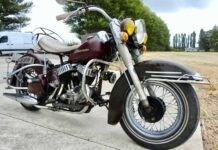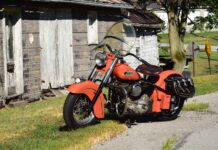The Outer Banks of North Carolina is a series of barrier islands that stretches 100 miles along the South Atlantic coast. Most Outer Banks Bike Week rallygoers tend to spend their time in Kitty Hawk, Nags Head and Kill Devil Hills, while some ride south to the Pea Island National Wildlife Refuge, Cape Hatteras National Seashore or take the ferry to Ocracoke Island. But this year, I decided to ride north of the Wright Memorial Bridge and explore the towns and beaches of the Currituck Outer Banks.
The farther north we rode on NC-12 from the intersection of Highway 158, the sparser this narrow spit of land becomes and, as the speed limit drops to 35 and then 25, the more relaxed the ride. We ride through the small town of Duck, named, not surprisingly, for the many ducks and wildfowl in the area. The population of this tiny burg is less than 400, but swells to more than 20,000 during the peak tourist season.

Whalehead Club
Farther north is the town of Corolla, with a population of about 500 that also increases by thousands in the summer months. We turn left at the sign for Currituck Heritage Park, about 20 miles from the Highway 158/NC-12 intersection, and park our bikes in front of the Whalehead Club for a tour.
In 1922, wealthy industrialist Edward Collings Knight Jr. purchased a 4.5-mile section of land in Corolla. He was a fervent waterfowl hunter and nature lover, and the newly married Mr. Knight brought his wife Marie-Louise to the area for their honeymoon where they began to plan for a modern-day residence. The old Lighthouse Club on the property was demolished and construction of the strikingly beautiful and spacious Art Nouveau structure was completed in 1925.
Upon Edward Knight’s death, Ray T. Adams bought the property and renamed it the Whalehead Club. He invited many prestigious guests to stay and also invest in the property, but when World War II broke out, it was leased to the Coast Guard. After the war, the property was returned to Mr. Adams who had big development plans, but he died suddenly in 1957 before they could be realized. The Whalehead Club then became a summer boarding school for boys, but closed in 1962. A series of ownership changes followed, with the structure eventually being abandoned and falling into a state of disrepair. In 1992 Currituck County bought the building and a few years later acquired the surrounding property, starting restoration in 1999. The house is now as close to its original state as possible, and the Whalehead Preservation Trust is focused on acquiring all furnishings, fixtures and artifacts from the original house, or if unavailable, recreating them. The tour is a fascinating glimpse into the privileged lives of the early owners, and is well worth a visit. There are several types of tours available from $12 to $25 per adult, and touring the grounds is free. (www.visitwhalehead.com)

Currituck Beach Lighthouse
Across the grounds of the Currituck Heritage Park stands the Currituck Beach Light Station, the last major brick lighthouse to be built on the North Carolina coast. There are currently five lighthouses in the Outer Banks, and this one is the northernmost of the group. It was built in 1875 to fill the “dark space” between the 40-mile-distant Cape Henry lighthouse in Virginia Beach, and Bodie Island, 40 miles to the south. The U.S. Coast Guard assumed responsibility for the lighthouse and it was electrified and automated by 1939. This timeframe is significant because “grid electricity” did not reach Corolla until the 1950’s!
We walked the circular stairway—220 steps to the highest observation point of the 162-foot structure. We could see magnificent 360-degree views of the ocean and surrounding sounds as well as all of Corolla, its beaches and the protected lands to the north. The lighthouse lens is first-order Fresnel, the largest of seven sizes, and is still in use today, enabling the beacon to be seen for 18 nautical miles. After extensive restoration of the lighthouse and the lighthouse keepers’ two Victorian-style dwellings in 1999, these structures were opened to the public. Admission is $8 for adults, and children 7 and under climb free with an adult. (www.currituckbeachlight.com)
Corolla Wild Horses
A mile and a half north is the southernmost tip of the Currituck Banks Reserve and the end of the road. Literally. NC-12 ends here and dumps you and your motorcycle into the sand if you don’t watch where you’re going. Unless you plan on parking the bike somewhere and walking, you will need a four-wheel drive vehicle to get onto the beach and travel any further.
There are a multitude of tour outfits that will take you four-wheeling on the beaches and offer sightings of the famed Corolla wild horses. It is believed that the first of these Colonial Spanish Mustangs came from European sailing vessels and may have been abandoned when the ships ran aground and had to lessen their loads. Other theories are that they, along with other livestock, were imported to the New World to help establish colonies, for transportation or to trade.

The horses have been studied periodically and their bloodlines are still pure, in part kept that way under the protection of Currituck County which designated its beaches as a Wild Horse Sanctuary in 1989, and due to the support of the Corolla Wild Horse Fund which conserves and responsibly manages the herd. The horses are considered a cultural treasure by the state of North Carolina and they roam free along the 11-mile stretch from the tip of Corolla to the Virginia border.
I selected one of the touring companies and signed up for a Saturday morning tour of the northern beaches. We piled into a truck set up like a safari vehicle with observation seats in the truck bed and began the leisurely 15-mph ride north. The tour guide took us through and around sand dunes, grasslands, maritime forests, brackish and freshwater marshes and tidal flats. The landscape was unreal; like nothing I’d ever seen before.

Much to my surprise, we began to see sandy roads leading to inland houses, some of which were small beach cottages and others multimillion dollar mansions. Who knew people lived in this remote setting? We passed through the communities of Seagull, Penny’s Hill, Swan Beach, North Swan Beach and finally Carova Beach, just south of the Virginia state line. I tried to imagine what it must be like to live there; all food and other supplies have to be brought in and out, there is no garbage pickup, and the closest gas station is in Corolla. But the rewards of living in this secluded splendor does have a certain allure.
We eventually did see a few of the wild horses, grazing peacefully in the sandy grass. They did not seem fazed by human presence, however, it is illegal to touch or feed them. They can often be seen frolicking in the surf, but today wasn’t our lucky day. The next time I visit this magnificent natural setting I will sign up with the Corolla Wild Horse Fund, which has begun offering its own tours. Two-hour tours start at $45, which is roughly equivalent to the other tour operators’ prices, but unlike the other tour operators, proceeds go directly to help care for the horses, supporting herd management, rescue and rehabilitation, sanctuary patrol and education. (www.corollawildhorses.com)
(This article Seaside Retreat was published in the July 2014 issue of Thunder Press, North edition.)


















